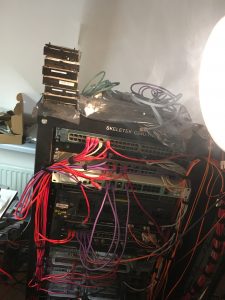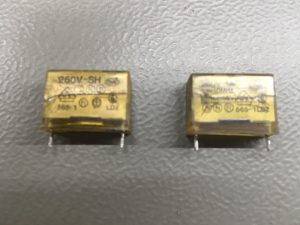The HP 8175A Digital Signal Generator
In the next couple of articles I’m going to take a look at this specialized piece of equipment: the HP 8175A digital signal generator.
The HP 8175A is a real best, it’s big, and weights a lot (about 17 KG). But it is a very nice piece of equipment to have in a Electronics LAB, especially when doing digital stuff.
The HP 8175A has 24 channels which can generate digital signals. And with option 002 installed arbitrary waveforms can be generated.
So I was surprised to find a listing for a HP8175 on Ebay located in Poland, where I could pick it up cheap. These devices are a special kit, and often sold as “untested” and therefore it’s possible to get a good deal on those devices.
Disaster strikes (or when things go boom in the LAB)
Once it arrived I did some checks before plugging in the power, and switching the device on: First I give the device a good shake. Not easy to with a big devices as this, weighting a 17Kg, but I managed it , and no rattling sound. Which is a good sign. Next I checked the voltage-line settings, and as I expected this was set to 240Volts.
Also very good. So at that point I plugged in the power, pressed the on button. And without any problems, the beast came alive.
After scrolling through the menu’s a heard a hissing noise followed by a loud b ang. And the next thing I noticed was that a lot of smoke was filling my lab.
ang. And the next thing I noticed was that a lot of smoke was filling my lab.
I switched off the HP8175A and unplugged the mains cord form the device.
The smell, was just horrible. It took day’s before the smell was gone, anyway I opened the device which was kind of a puzzle since I don’t have the service manual for it.
So I used the tactics: See a screw: remove that screw. Not alway’s the best practise, certainly not in this case, this device got a lot of screws. And I mean a lot. But finally I got inside and again I was impressed by the build quality as  I aspect from these old HP devices. The power supply is completely shielded. Every board is connected to the main motherboard, and once a metal plate on the back is unscrewed, giving access to the POD connectors, each board can be slide out of the chassis.
I aspect from these old HP devices. The power supply is completely shielded. Every board is connected to the main motherboard, and once a metal plate on the back is unscrewed, giving access to the POD connectors, each board can be slide out of the chassis.
However the metal plate on top must be removed to gain, the rod to the power button must be removed to allow the power board to be slide out. After taking the power board out I could not see any damage. And a aspected, a filter cap has blown. These caps are famous for letting the magic smoke escape: RIFA cap’s. These caps over time get little cracks in their plastic housing, allowing moisture to get into the capacitor, which eventually will let out the magic smoke, with a bang.If these caps go..
I could not see any damage. And a aspected, a filter cap has blown. These caps are famous for letting the magic smoke escape: RIFA cap’s. These caps over time get little cracks in their plastic housing, allowing moisture to get into the capacitor, which eventually will let out the magic smoke, with a bang.If these caps go..
They go violently. As I noticed. Since these are just filter capacitors, the device can run perfectly without them. Of course these filter caps must be replaced, but it’s not a problem to remove the cap’s from the Power Supply. And after de-soldering the cap and putting back the HP into one piece, I finally got to play with the device.
In part 2 of I’m going to look at what this beast can do.

Hi there,
I’ve found your Blog for the HP 8175A…
I’ve another happy userof the 8175a with option 2 😉
But mainly I try to looking for the user manual ( obviously with out opt 2 description…)
Just in case, someone of you have a pdf version ?
Thanks in advance… to you all
p@